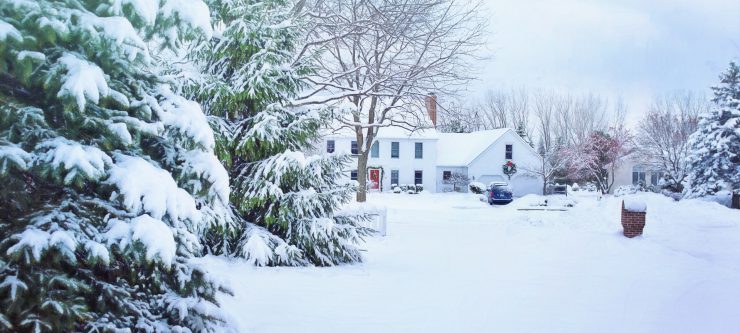When winter hits, the cold temps and massive amounts of snow can put your house to the ultimate test. To make sure your home is still standing come March, take a stroll through your home to see if you’re following these necessary precautions.
Indoor Prep
Sealing Air Leaks
Windows, doors, and their trim work are great at inviting cold, outside air into your home. Use the flicker of a candle or the back of your hand to find places where cold air is leaking in (and where your precious heat is escaping!).
Use a caulking to seal any gaps around windows and trim. For leaky doors, use felt or foam weather stripping and door sweeps. These are all cheap and easy to work with.
Shut Off Water To Hoses
When water sits in pipes that lead to the outside, cold temps can freeze, expand, and burst out, turning your basement into a swimming pool. Find the valves of the pipes leading to your outside faucets (they’ll be inside your home near the main water shutoff valve) and turn them off. Then drain the water from the faucet on the side of your house.
Close Chimney Damper
When you’re not using your wood-burning fireplace, close the chimney damper to prevent drafts of cold air from coming into your home. You should also have your chimney inspected and cleaned to prevent fire damage during those cozy winter evenings by the fireplace.
Insulate Pipes In Cold Areas
Add insulation sleeves over water pipes in cold areas of your home, like the attic, basement, and crawl spaces. When these water pipes get too cold, they can freeze and burst.
Change Furnace Air Filter
A clean air filter can keep warm air moving and energy costs down. Replace your furnace filter before winter (every 3 months during the warm seasons) and every month throughout the winter.
Program Your Thermostat
Programming your thermostat can also bring down your energy costs. Set your daytime temp to a comfortable level (68F to 75F is often preferred) and a lower temperature at night when you’re bundled up in bed (maybe around 60F to 68F). If the house is empty during the work or school day, program a lower temp then as well.
Reverse Ceiling Fans
Many homeowners don’t realize that ceiling fans have two spinning options: clockwise and counterclockwise. Your fan should spin clockwise during the winter to allow warm air above your head to be pulled down, and counterclockwise in the summer so cold air at your feet rises up.
Check the center of your fan for a small switch to change the spin when the temperatures start dropping.
Stock Up For The Snow
It’s hard to drive to the store to buy a shovel when your driveway is buried under 4 feet of snow. Head to the store early to get your winter gear if you don’t have them already:
- Ice-melting sidewalk salt
- Snow shovels
- Car window scrapers
- Snow shoveling apparel (boots, gloves, mittens, hot cocoa)
- Winter windshield wiper fluid
- A snow blower (and gas, oil, spark plug, etc.)
Outdoor Prep
Have Your Sprinkler System Drained
If you have an in-ground sprinkler system, have your pipes drained and prepped for the winter. This is different than draining your outside faucets, so be sure to do both!
Prepping a sprinkler system is usually better left to a professional, but the labor costs are much lower than renovating a flooded basement.
Check The Roof For Damage
Take a look at your roof. See if you have any missing or damaged shingles or flashing, or drill holes that haven’t been sealed. Any puncture in your roofing can lead to leads and mold.
Clean Your Gutters
Once the leaves stop falling, grab a ladder and get to work on those gutters. Since leaves and debris will impede water flow in gutters, any melting snow will quickly form icicles. Falling water also damages grass and sidewalks.
Store Away Outdoor Items
Pack up outdoor furniture, hoses, and decorations that can get damaged in the cold temps and snow. Don’t forget about seasonal plants in the garden, and draining the gas out of your mower.
Review Winter Emergency Plans
When a pipe bursts and is flooding the basement, seconds count. This makes it important for you and your family to know what to do in case of a winter emergency.
Make sure every occupant knows where the main water shutoff valve is and how to turn it. You should also have a list of emergency water damage and storm damage contractors ready to call if disaster happens.
Trim Tree Branches
Are any tree branches swaying dangerously close to your roof or siding? Strong winter winds and heavy snow can easily give tree branches extra space to swing, so trim them to be about 3 to 8 away from your home.
Cover Vents To Prevent Nesting
Birds and rodents love to find warm places in the winter to set up shop. Make sure you have possible entrances blocked off:
- Dryer vent
- Bathroom exhaust vent
- Stove exhaust vent
- Chimney
- Attic vents and windows
